The history of the Department of Dermatology at UKE (Univerity Hospital Hamburg Eppendorf)
The history of the department of Dermatology at the University Hospital Hamburg starts with the year 1907. That year,
Paul Gerson Unna was the first medical doctor who was not an employee of the state, who was appointed as a professor (tenure). As a 'specialty doctor for skin diseases' he became the first head of the department of dermatology, which consisted of 2 buildings (pavillions, pav. 55 for male patients, pav. 42 for female patients), with a total of 16 beds.
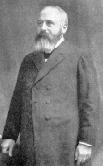 |
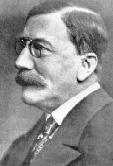 |
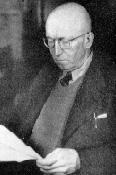 |
|
Paul G. Unna |
Eduard Arning |
Paul Wichmann |
Between 1914 - 1917 no patients were treated here due to the First World War. In late fall 1918, the dermatologic clinic, now in barracks, was reopened. At the same time, it was decided to have all departments join academic teaching, so that the dermatologic department in St. Georg, headed by
Eduard Arning, was also upgraded to an academic teaching hospital (University Clinic). As the conditions at St. Georg were better at those times, lectures were held almost exclusively at the auditorium there.
On April 1st, 1921 P.G. Unna resigned from his teaching and honorary professorship and gave up his position at the Hospital at Eppendorf.
In the spring of Eduard Arning rejected an appointment at the clinic in Eppendorf as it would have meant moving there. After establising an extraordinate professorship for dermatology on May 25th, 1921, also the second on the list, Prof Zieler (Würzburg) refused a position, as negotiations on equipment of the outpatient clinic, amount of staff and equipment of the clinic with an x-ray machine, failed.
In the meantime, the tenure position for the department of radiology was turned into a tenureship for dermatology, as confirmed on April 26th 1922 by the senate of Hamburg. However, the position was not to be filled before 1924. Up to that point, Eduard Arning, whose department of dermatology at St. Georg had grown to 470 beds, was responsible for most of the teaching in dermatology.In Eppendorf, W. Patzschke, a student of Unna was in charge of the 100 beds of his department at Eppendorf, as well as another 100beds at Eilbek (as overhang). Patzschke, as well as Arning and Unna (who was still working at his "Dermatologicum" ) were in charge of the lectures for dermatology.
As early as 1912
Paul Wichmann, a dermatologist in private practice, with focus on treatment of Lupus, managed to set up a treatment house for lupus patients (with the help of donations) adjacent to the premises of the hospital Eppendorf. The building was constructed by Haller and Geissler (who also built the Hamburg townhall), enlarged only 2 years later and on July 31st 1923 was taken over, free of charge by the Hospital of Eppendorf. Wichmann took over the vacant position of attending to this depaertment and in 1924 he was honored with a title of professor.
In constructing a building for dermatology, the vacant chairposition was also available and as Arning due to his age (68years) was not eligible, P. Mulzer (Munich) was chosen.
P. Mulzer started the first tenured chairmanship for dermatology at hamburg on October 15th, 1924. He also took over the treatment house for lupus patients, later to be called main building, and 4 barrack with an overall of 140 beds that had previously been used during edidemics. During his chairmanship, a seroloic and histologic laboratory, the photolab, the collection of moulages and the library were establishes, also x-ray machines were bought.
Mulzer was put on temporary leave on May 22nd, 1945 and was dicharged on command of the military establishment on July 2nd 1945. Thus, again 3 years without chairmenship ensued.
during this time, Hopf (Akrokeratosis verruciformis) and later Jordan took over the interrims chairmanship of the department. In 1946, Alfred Marchionini primo et unico loco was appointed for the vacant chairmanship. During his negotiations, he demanded as "conditio sine qua non" the construction of a new building for the Department of dermatology.
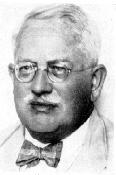 |
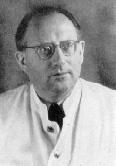 |
|
P. Mulzer |
Alfred Marchionini |
On May 1st, 1948
Alfred Marchionini took over the chair of the department. His main focus was targeted at re-establishing the cooperation with departments abroad.
He succeeded in doing so by organizing a celebration in the honor of Unna which led to the re-vitalization of teh activities of the German Academy of dermatology and also resulted in the organiozation of the first annual post-war conference of this society.
In October of 1949, after a year long planning, the first construction of the new department of dermatology began, with the cornerstone being laid on March 31st, 1950. The basic contruction was completed in December of the same year and Marchionini attended the celebrations as an honorary guest, as he had already accepted a chairmanship in Munich, succeeding Ritter v. Zumbusch.
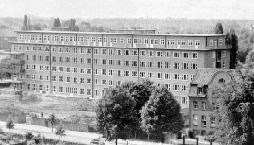 |
|
Department of Dermatology 1952 |
 |
Opening of the new Operating Room, 1953
Mayor Max Brauer, Senator Schiller, Prof. Kimmig |
In 1952 the new 6-level building of the Department of Dermatology was opened. It consisted of 6 wards ( 2 female, 2 male, 1 childrens' ward and 1 lupus ward) with a total of 155 beds.
Apart from the beds, it had one of the most modern outpatient clinics, a photography department, a radiation unit, 2 operation rooms, a unit for cosmetic operations, labs for research and routine procedures,
an office for the director of the department and a library. In addition to this, the department was equipped with the most modern facilities for kitchen, waste disposal, etc. of its times (7 elevators for food deliveries, 2 elevators for transport of beds, 1 elevator for people, air-conditioning in the operating rooms, in the radiation unit, in the lab and in some of the patients' rooms). Also an intercom system, as well as a paging system (through clocks) was installed.
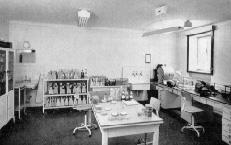 |
|
Mycology lab |








